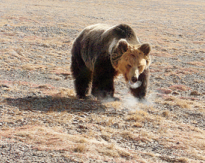 A brown bear is seen in the Changthang National Nature Reserve in Nagchu, Tibet autonomous region. CHINA DAILY
 Rangers feed an injured Tibetan antelope in the Silingtso National Nature Reserve in Nagchu. CHINA DAILY
Every morning after breakfast, Tharchen sets out to patrol the vast grasslands on a motorbike. As he rides along the sandy track, a billowing cloud of dust forms, and gradually Tharchen disappears. He's in Shanza county in the Tibet autonomous region, part of the Changthang National Nature Reserve.
Covering an area of 298,000 square kilometers, Changthang is China's biggest reserve and has become a haven for wildlife on the high plateau.
Tharchen is one of 42 rangers in the county working to protect wildlife, despite the cold, thin air at this high altitude.
Patrolling is vital to the reserve, a safe habitat for many rare species such as wild yaks, blue sheep, Tibetan antelopes, black-necked cranes, snow leopards and Tibetan wild asses. Tharchen helps protect them from poaching and flu epidemics, and the wetlands from damage.
With their motorbikes, telescopes and notebooks, rangers leave a footprint in every corner of the grasslands. June is the busiest time of the year, as that's when Tibetan antelopes give birth.
"In the summer, our daily work involves patrolling for six to eight hours, up to 300 kilometers per day," Tharchen told Tibet Daily.
He spoke of the unusual rescue of a Tibetan wild ass in 2020. Alerted by herdsmen, he and his team found the animal stuck deep in a swamp, but they were able to pull it out using ropes.
"Our clothes got wet, and we shivered in the freezing cold after the rescue," the 34-year-old said.
There has been a steady increase in the populations of rare species unique to the region in recent years. Benefiting from efforts to protect biodiversity, the Tibetan antelope population has grown to more than 200,000 from fewer than 70,000, the Tibetan wild ass population to nearly 90,000 from 50,000, and black-necked cranes to more than 8,000 from between 1,000 to 3,000.
According to Yugnyan, project officer with the Shanshui Conservation Center, an environmental conservation NGO, conflicts between herders and wildlife have increased in recent years due to the growth of wild populations thanks to enhanced protection efforts.
"In the Nujiang River valley in Dechen county, Yunnan province, there are frequent reports of wildlife harming livestock. So we pay compensation to those that haven't been compensated by the government livestock insurance scheme," Yugnyan said.
Galuk, a village official in Dechen, said that the residents benefit from the center's ecological protection project funds.
"Not all the families in our village get compensated when their animals are harmed by wildlife, in part because they are unable to report the cases on time because they live in such remote locations," Galuk said.
"Some fail to send claims to the insurance company because of the lack of transport or communications. And some people don't know how to fill in the forms for compensation because they don't know how to read or write."
By PALDEN NYIMA in Lhasa |
- Home
- News Tibet |Exclusive |China |World |Related News |Latest
- Documents White Papers |Others
- Photo Politics |Economy & Society |Culture & Religion |Human & Nature |Beautiful Tibet |Other Tibetan-Inhabited Area |Exchanges |Related
- Video News |Documentary |Micro-Video |Entertainment
- Art
- Tourism
- In Focus
- About Tibet






